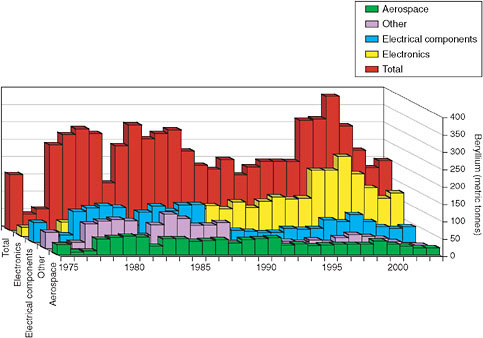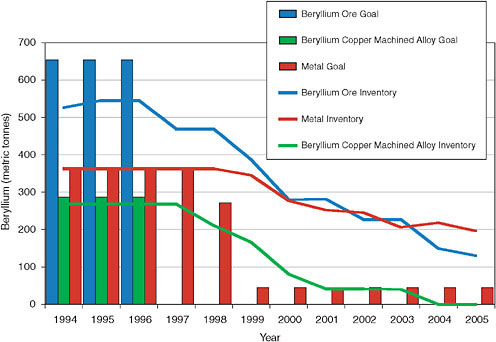F
Case Study: Beryllium
The United States is one of only three countries known to process beryl ores and beryllium concentrates into beryllium products. Brush Resources, Inc., a subsidiary of Brush Engineered Materials (BEM), extracts bertrandite from open pit mines near Delta, Utah, and converts the bertrandite, along with imported beryl and beryl from the NDS, into beryllium hydroxide.
At year-end 2005, BEM reported proven bertrandite reserves in Utah of about 5.99 million dry metric tons. This represented about 16,000 tons of contained beryllium, which would be sufficient for more than 100 years of operation based on average production levels in recent years.1 Thus, there is no shortage of raw material. The problem is production capacity.
Beryllium is highly toxic and there have been several health and environmental problems reported. Correction of those problems is driving up the cost of producing beryllium and stimulating interest in the development of substitute materials. Table F-1 shows the uses of beryllium. Consumption by use is shown in Figure F-1. Since 1999, consumption has been declining. Electronics has been the largest user.
In 1994, after completing its assessment of the stockpile requirements, the Institute for Defense Analysis concluded there was no need to stockpile beryllium, and in 1995 DoD recommended to Congress that the beryllium goals be dropped to zero. On March 25, 1996, DoD released an assessment of the global advanced
TABLE F-1 Uses of Beryllium
|
National Defense |
Commercial |
|
Airborne forward-looking infrared systems Guidance systems on existing strategic missiles Surveillance, communications, and other satellites Missile defense systems Aircraft brakes Nuclear reactor rods and warheads |
Battery contacts and electronic connectors in cell phones and base stations Aerospace castings High-definition and cable television Underwater fiber-optic cable systems High-density circuits for high-speed computers and automotive ignition systems Pacemakers and other medical devices |

FIGURE F-1 Annual consumption of beryllium by end use. SOURCE: USGS Minerals Yearbook (2005).
materials technology and industrial base.2 According to the press release that accompanied that report’s release,
This assessment found that there are no issues of assured, affordable access to the specialty metals of superalloys, titanium and beryllium, and that industry downsizing to reduce overcapacity will not be inconsistent with future defense requirements.
|
2 |
DoD, Memorandum for Correspondents (Memorandum No. 045-M, March 25, 1996). Available at http://www.defenselink.mil/news/Mar1996/m032596_m045-96.html. Accessed June 2007. |

FIGURE F-2 The trend in inventories and goals by type of beryllium. SOURCE: Data from USGS, Minerals Yearbook, various years.
Congress subsequently authorized disposal of all beryl ore and BCMA and a portion of the beryllium metal inventory (Figure F-2).
In 2000, BWI mothballed its beryllium metal production facility in Elmore, Ohio, citing obsolescence, economic, health, and safety reasons. The availability of excess inventory from the NDS may also have been a factor. It is not clear what, if any, reaction the DoD had to the closure, since no action was reported publicly by the government until 2003.
The issue of a domestic production source for beryllium was raised in the May 16, 2003, report of the House Armed Services Committee that accompanied its version of the FY2004 National Defense Authorization Act:3
The committee is aware that the domestic supply of the strategic and critical metal beryllium is in danger of being depleted. Metallic beryllium is used extensively in DOD weapons systems, DOE strategic nuclear applications and several critical civilian applications. Moreover, the only domestic producer of metal beryllium has closed its primary metal production plant because of obsolescence. Therefore, the committee directs that the
|
3 |
Available at http://www.dod.mil/dodgc/olc/docs/2004NDAA.pdf. Accessed September 2007. |
DOD conduct an in-depth study of the beryllium supply issue and make recommendations regarding how future access to beryllium could be assured.
Section 824 of the FY2004 National Defense Authorization Act directed the Secretary of Defense to submit a report by March 31, 2005, providing information on the following:
-
The long-term supply of beryllium,
-
The need for modernization of the primary sources of production of beryllium,
-
Concepts for meeting the future defense requirements for beryllium, and
-
Plans for maintaining a stable domestic industrial base for sources of beryllium through cooperative public-private partnerships, administration of the NDS, and other means.
A summary of the findings of the subsequent DoD study was included in the Annual Industrial Capabilities Report to Congress, issued in February 2005 (hereinafter called the 2005 Capabilities Report).4 The report noted that the United States had lost its only capacity to manufacture primary beryllium metal in 2000, when the only producer, BWI, mothballed its production facility. Since then, BWI had relied on a dwindling supply of beryllium ingot from the NDS, which it purchased to meet defense and other needs for high-purity beryllium metal products.
The report estimated that the depletion date for NDS beryllium ingot inventories, based on annual growth in demand of 6 percent over at least the next 5 years, would be 2008. That could be extended until 2011 if anticipated imports of beryllium from Kazakhstan are sufficiently pure for lower purity applications. The 2005 Capabilities Report noted that it would take 3-5 years to design, permit, construct, equip, and test a new primary beryllium facility no matter whether the manufacturing technology employed is the current one or a newer one.
Once the ingot is exhausted, beryllium in the form of hot pressed powder billet being held in reserve at the NDS could extend the depletion date for a few years if it is made available to the private sector. However, the report said that these reserves of beryllium should be released only as a last resort, serving as a hedge against delays in bringing the new facility on line.
The report concluded that even if the beryllium from Kazakhstan turned out to be pure enough for high-purity applications, the risks were too great:
|
4 |
Available at http://www.acq.osd.mil/ip/docs/annual_ind_cap_rpt_to_congress-2005.pdf. Accessed September 2007. |
-
Dependence on Kazakhstan for production and Russia for feedstock and
-
Transfer of BWI manufacturing technology to Kazakhstan could lead to the sale of high-purity beryllium metal to third-party countries, which might use it to make nuclear weapons or defense-related products.
The 2005 Capabilities Report concluded that while imports are not a viable long-term option, private commercial investment is highly unlikely to be adequate. It suggested that the DoD begin a multiyear cost-share program with private industry, possibly through the Defense Production Act, to support the design, construction, and equipping of a new beryllium metal production facility, with the DoD share at $30 million to $45 million.
In response to the DoD report, the defense appropriations bill for 2005 directed that $3 million appropriated in the Defense Production Act be used for preliminary plant design, for a review of the permitting process, and for developing a 5-year plan to build the new plant. In the FY2006 President’s Budget Request, DoD requested $6 million for the project, and Congress appropriated $7.8 million.
On November 30, 2005, BWI of Cleveland, Ohio, was awarded a contract to develop technology, and it agreed to share the cost of reestablishing and maintaining a domestic production capacity for primary, high-purity beryllium metal.
The DoD requested $7.5 million in 2007, and that was appropriated. Its budget submission for 2008 indicated that it planned to budget an additional $22.5 million for the project ($7.5 million in each year from 2008 through 2010). Thus, $40.8 million of federal funds is projected to be spent for the new facility.
DoD has been sponsoring research to develop substitute materials for beryllium. Two examples follow:
-
In 2002, the Missile Defense Agency solicited proposals for substitutes.5 The objective was to investigate and define a suitable beryllium substitute or beryllium alloy substitute that is affordable, possesses the appropriate profile and characteristics of beryllium or beryllium alloy, is producible in a production environment, and does not pose any of the health hazards associated with beryllium or beryllium alloy.
-
In 2006, the Army solicited proposals for a similar project.6 Its objective was the development of safe (nontoxic), reliable, cost-effective, and efficient composites that could replace beryllium components. The solicitation noted that previous work sponsored by the Navy (1980-1995) had demonstrated the possibility of developing composite materials with properties similar to those of beryllium for structural components.
Whether significant progress on substitutes has been made is unclear at this time.
The requirement for stockpiling beryllium hot-pressed powder is driven not by the need to replenish after a conflict but by the need to assure a continuous supply to meet DoD and DOE programmatic needs attributable to the recent shutdown of the sole domestic processor of beryllium ore concentrates. As foreign suppliers are not considered reliable and the limited domestic supplies are being depleted it has been recommended that the current inventory be retained until the supply uncertainties are resolved.
This example shows that in some cases, use of Defense Production Act authorities to guarantee a U.S. source for a critical material may be preferable to maintaining a stockpile of such material.






